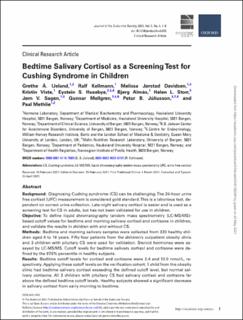| dc.contributor.author | Ueland, Grethe Åstrøm | |
| dc.contributor.author | Kellmann, Ralf | |
| dc.contributor.author | Davidsen, Melissa Jørstad | |
| dc.contributor.author | Viste, Kristin | |
| dc.contributor.author | Husebye, Eystein Sverre | |
| dc.contributor.author | Almås, Bjørg | |
| dc.contributor.author | Storr, Helen L. | |
| dc.contributor.author | Sagen, Jørn Vegard | |
| dc.contributor.author | Mellgren, Gunnar | |
| dc.contributor.author | Juliusson, Pétur Benedikt | |
| dc.contributor.author | Methlie, Paal | |
| dc.date.accessioned | 2021-07-09T13:00:17Z | |
| dc.date.available | 2021-07-09T13:00:17Z | |
| dc.date.created | 2021-05-20T15:32:13Z | |
| dc.date.issued | 2021 | |
| dc.identifier.issn | 2472-1972 | |
| dc.identifier.uri | https://hdl.handle.net/11250/2764083 | |
| dc.description.abstract | Background
Diagnosing Cushing syndrome (CS) can be challenging. The 24-hour urine free cortisol (UFC) measurement is considered gold standard. This is a laborious test, dependent on correct urine collection. Late-night salivary cortisol is easier and is used as a screening test for CS in adults, but has not been validated for use in children.
Objective
To define liquid chromatography tandem mass spectrometry (LC-MS/MS)-based cutoff values for bedtime and morning salivary cortisol and cortisone in children, and validate the results in children with and without CS.
Methods
Bedtime and morning salivary samples were collected from 320 healthy children aged 4 to 16 years. Fifty-four patients from the children’s outpatient obesity clinic and 3 children with pituitary CS were used for validation. Steroid hormones were assayed by LC-MS/MS. Cutoff levels for bedtime salivary cortisol and cortisone were defined by the 97.5% percentile in healthy subjects.
Results
Bedtime cutoff levels for cortisol and cortisone were 2.4 and 12.0 nmol/L, respectively. Applying these cutoff levels on the verification cohort, 1 child from the obesity clinic had bedtime salivary cortisol exceeding the defined cutoff level, but normal salivary cortisone. All 3 children with pituitary CS had salivary cortisol and cortisone far above the defined bedtime cutoff levels. Healthy subjects showed a significant decrease in salivary cortisol from early morning to bedtime.
Conclusions
We propose that bedtime salivary cortisol measured by LC-MS/MS with a diagnostic threshold above 2.4 nmol/L can be applied as a screening test for CS in children. Age- and gender-specific cutoff levels are not needed. | en_US |
| dc.language.iso | eng | en_US |
| dc.publisher | Oxford University Press | en_US |
| dc.rights | Attribution-NonCommercial-NoDerivatives 4.0 Internasjonal | * |
| dc.rights.uri | http://creativecommons.org/licenses/by-nc-nd/4.0/deed.no | * |
| dc.title | Bedtime Salivary Cortisol as a Screening Test for Cushing Syndrome in Children | en_US |
| dc.type | Journal article | en_US |
| dc.type | Peer reviewed | en_US |
| dc.description.version | publishedVersion | en_US |
| dc.rights.holder | Copyright The Author(s) 2021 | en_US |
| cristin.ispublished | true | |
| cristin.fulltext | original | |
| cristin.qualitycode | 1 | |
| dc.identifier.doi | 10.1210/jendso/bvab033 | |
| dc.identifier.cristin | 1911115 | |
| dc.source.journal | Journal of the Endocrine Society (JES) | en_US |
| dc.source.pagenumber | 1-8 | en_US |
| dc.identifier.citation | Journal of the Endocrine Society. 2021, 5 (5), 1-8. | en_US |
| dc.source.volume | 5 | en_US |
| dc.source.issue | 5 | en_US |

